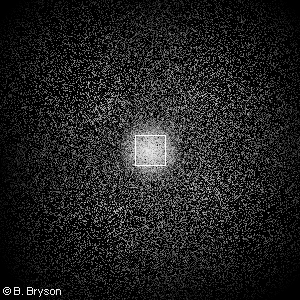Scale: 10-10 meters = 0.1 nm = 0.1 nanometer = 100 pm = 100 picometers
Carbon's Outer ShellWe are looking at the outer electron cloud (the p-shell) of a carbon atom. Instead of individual electrons, we are seeing a representation of the cloud of negative charge associated with carbon's four outer electrons. The more defined cloud in the center is the s-shell containing the inner two electrons. Neutral carbon has a total of six electrons to balance the six protons in its nucleus. At the atomic scale represented here, chemical bonding takes place in the outer shells of atoms as they share electrons. Carbon is in the second row of the periodic table of elements. Atoms in the second row are most stable when they have either two electrons or ten electrons. Having six electrons, carbon can share up to four electrons with a large variety of other elements. This property accounts for the multitude of compounds containing carbon atoms and allows for the complexity needed for life to evolve and adapt. The branch of chemistry involving the study of carbon compounds is called organic chemistry. Copyright © 2016 by Bruce Bryson |
